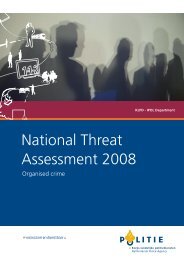Assessing the Effectiveness of Organized Crime Control Strategies ...
Assessing the Effectiveness of Organized Crime Control Strategies ...
Assessing the Effectiveness of Organized Crime Control Strategies ...
Create successful ePaper yourself
Turn your PDF publications into a flip-book with our unique Google optimized e-Paper software.
One high-pr<strong>of</strong>ile investigation, conducted by <strong>the</strong> United States’ Internal Revenue Service during<br />
<strong>the</strong> 1960s, was Operation Tradewinds (Block, 1991). This investigation developed information<br />
on OC figures and o<strong>the</strong>rs who took money made illegally to <strong>the</strong> Bahamas and invested it <strong>the</strong>re.<br />
Weak regulations and lax enforcement turned <strong>the</strong> Bahamas into a tax haven for various forms <strong>of</strong><br />
tax scams. After ten years, <strong>the</strong> operation produced $25 million in taxes and penalties and<br />
initiated 13 investigations resulting in criminal proceedings. Although seriously under funded,<br />
Tradewinds generated critical information (Block, 1991). On <strong>the</strong> downside, <strong>the</strong> project produced<br />
some undesirable consequences with regard to foreign policy (i.e., conflicts with Bahamian<br />
authorites) and was controversial in its intrusion into <strong>the</strong> private financial dealings <strong>of</strong> Americans<br />
(Rhodes, 1984: 73-74).<br />
4.4 Monitoring Financial Transactions and Tackling Money Laundering<br />
In <strong>the</strong> United States alone, drug trafficking and o<strong>the</strong>r pr<strong>of</strong>it-motivated crime generate in excess<br />
<strong>of</strong> $300 billion annually (Karchmer and Ruch, 1992:1). The risks associated with <strong>the</strong><br />
accumulation <strong>of</strong> and transactions in large sums <strong>of</strong> cash earned illicitly are substantial, as <strong>the</strong>se<br />
assets may be seized and <strong>the</strong> owner may face criminal prosecution. Hence, to obtain <strong>the</strong> full<br />
benefit <strong>of</strong> illicit activities, <strong>of</strong>fenders must convert <strong>the</strong>ir cash proceeds <strong>of</strong> crime to ano<strong>the</strong>r form in<br />
order to engage in everyday commerce. Money laundering has been described as, “<strong>the</strong> process<br />
<strong>of</strong> converting illegally earned assets, originating as cash, to one or more alternative forms to<br />
conceal such incriminating factors as illegal origin and true ownership” (Karchmer and Ruch,<br />
1992:1).<br />
Money laundering schemes vary in complexity (Beare, 1996:102-106), depending on <strong>the</strong><br />
distance that criminals wish to put between <strong>the</strong>ir illegally earned cash and <strong>the</strong> laundered asset<br />
into which that cash is converted. Banks and o<strong>the</strong>r financial institutions, for example, issue<br />
negotiable instruments such as cashier’s checks and money orders in exchange for cash. These<br />
funds can <strong>the</strong>n be used to acquire assets (e.g., legitimate businesses) that provide <strong>of</strong>fenders with<br />
a source <strong>of</strong> income that appears legitimate and confers on <strong>the</strong>m an image <strong>of</strong> respectability.<br />
Businesses with high volumes <strong>of</strong> cash sales (e.g., restaurants, bars) are especially attractive, as<br />
business volume is difficult to ascertain accurately during audits.<br />
Also, laundering specialists may be retained; e.g., couriers to transport currency to laundering<br />
sites and lawyers to create trust accounts and transfer funds to a foreign account. Full-service<br />
organizations have been set up to facilitate money laundering. Perhaps <strong>the</strong> most notorious was<br />
<strong>the</strong> Bank <strong>of</strong> Commerce and Credit International (BCCI). Shut down by regulators in several<br />
countries, it was referred to as “<strong>the</strong> most pervasive money laundering operation and financial<br />
supermarket ever created” and as a “steering service” for Colombian drug traffickers to deposit<br />
hundreds <strong>of</strong> millions <strong>of</strong> dollars (Webster and McCampbell, 1992: 1).<br />
One method available to detect money laundering schemes involves <strong>the</strong> analysis <strong>of</strong> currency<br />
transactions. Canada, <strong>the</strong> US, Australia, <strong>the</strong> UK, and o<strong>the</strong>r countries require that financial<br />
institutions record or report large transactions (usually sums <strong>of</strong> $10,000 or more) and/or report<br />
suspicious transactions. Lawyers and financial advisors, too, are required to report suspicious<br />
transactions in various countries, although Canadian legislation exempts lawyers from doing so<br />
(Porteous, 2003: A15). US legislation also requires <strong>the</strong> reporting <strong>of</strong> <strong>the</strong> transportation <strong>of</strong><br />
Research and Statistics Division / Department <strong>of</strong> Justice Canada | 23








